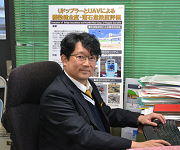Railway Dynamics Division
Profile
The main subject of Railway Dynamics Division is the dynamics of the railway structures, tracks, vehicles and overhead contact lines. The main investigations are the dynamic interaction problems between railway structures, tracks and vehicles, between wheel and rail, and between pantograph and catenary. In order to propose the innovative technologies for improving performance, safety and efficiency of railway system, it is essential to carry out basic researches on such interface problems. The laboratories in Railway Dynamics Division cooperate closely with each other and also the other divisions such as Structures Technology, Track Technology, Vehicle Structure Technology and Power Supply Technology Divisions. In addition, applied researches and developments such as design and maintenance standards, new bogie structures and new track structure are carried out, enhancing the outputs of basic researches.
Introduction
 To create innovative technologies which achieve improvement in safety and reliable, labor-saving of maintenance work, and environmental friendliness of railway system, clear understanding of various dynamic behavior observed in railway structures, tracks, vehicles and overhead contact lines is essential. Therefore, our research division has been tackling basic researches on clarification of these dynamic behaviors and development of required analysis methods and measurement methods, as well as application researches on design and evaluation methods of railway system and proposition of unique next-generation railway system based on the basic researches. Our research division has also been grappling with construction of advanced numerical simulation tools.
To create innovative technologies which achieve improvement in safety and reliable, labor-saving of maintenance work, and environmental friendliness of railway system, clear understanding of various dynamic behavior observed in railway structures, tracks, vehicles and overhead contact lines is essential. Therefore, our research division has been tackling basic researches on clarification of these dynamic behaviors and development of required analysis methods and measurement methods, as well as application researches on design and evaluation methods of railway system and proposition of unique next-generation railway system based on the basic researches. Our research division has also been grappling with construction of advanced numerical simulation tools.
Laboratories and their field
Vehicle Mechanics
Vehicle mechanics laboratory addresses tasks to elucidate the phenomena related the dynamics of railway vehicles in order to improve the running safety and the riding comfort. Vehicle dynamics during earthquake, wear performance of wheel and rail, and aerodynamic vibration of vehicle, which are issues to be solved with other research field, are our initial research topics. We are also tackling new vehicle devices to improve the curving performance for running safety, developed a new type bogie for reducing the risk of derailment, some parts of bogie for countermeasure against earthquake.
Current Collection
Main research area of this laboratory is dynamic behavior between overhead contact lines and pantograph for improving current collection performance. We are also addressing development of measurement equipments to grapple with dynamic behavior of catenary system. Furthermore, reducing aero-acoustic noise emitted from pantograph for high speed train is our major challenge.
Track Dynamics
Track dynamics laboratory focuses on the research topics such as adhesion phenomenon between wheel and rail under various contact conditions; generation mechanism of rolling contact fatigue, damage and wear; dynamic response characteristics of ballast railway track by the running vehicle and its destruction mechanism, by means of theoretical and experimental simulations methods.
Structural Mechanics
The main objective of the research of Structural Mechanics Laboratory is to pursue the ideal structure and track which improve running safety of railway vehicle, reduce disaster damage, improve harmony with an environment and efficiency of maintenance, and reduce total cost. For this objective, we are working on researches about improving numerical simulation techniques, constructing measurement and evaluation methods, and developing new structure types based on numerical simulations and experiments.
Computational Mechanics
Computational Mechanics Laboratory works to introduce the advanced analysis technique using HPC (High performance Computing), with the goal of clarifying dynamic phenomenon to optimize the railway system. In particular, we are promoting analysis of dynamic behavior of rolling contact between wheel and rail, precise analysis of aerodynamic characteristic for railway vehicle and analysis of snow accretion using large-scale parallel computing, in order to resolve problems specific to railway.
Research Division
- Vehicle Technology Division
- Structure Technology Division
- Power Supply Technology Division
- Track Technology Division
- Disaster Prevention Technology Division
- Signalling and Operation Systems Technology Division
- Information and Communication Technology Division
- Materials Technology Division
- Railway Dynamics Division
- Environmental Engineering Division
- Human Science Division
- Maglev Systems Technology Division
- Center for Railway Earthquake Engineering Research
- Vehicle Technology Division
- Structure Technology Division
- Power Supply Technology Division
- Track Technology Division
- Disaster Prevention Technology Division
- Signalling and Operation Systems Technology Division
- Information and Communication Technology Division
- Materials Technology Division
- Railway Dynamics Division
- Environmental Engineering Division
- Human Science Division
- Maglev Systems Technology Division
- Center for Railway Earthquake Engineering Research
